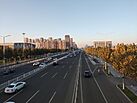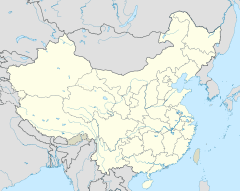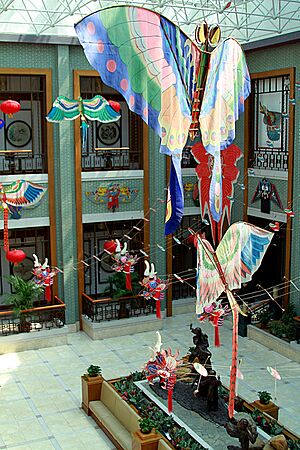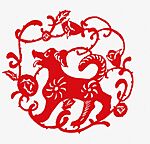Weifang facts for kids
Quick facts for kids
Weifang
潍坊市
|
|
|---|---|
|
Prefecture-level city
|
|
|
Left to right, top to bottom: Skyline viewed from the Fuwah Park Ferris Wheel, the Bailang River, Kuiwenmen Street, Weifang Middle Road with Weifang University visible to the left, Weifang Grand Theater
|
|
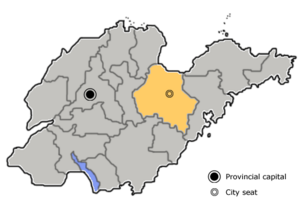
Location of Weifang City jurisdiction in Shandong
|
|
| Country | People's Republic of China |
| Province | Shandong |
| Municipal seat | Kuiwen District |
| Subdivisions |
List
Districts
Weicheng Kuiwen Fangzi Hanting County-level cities Qingzhou Zhucheng Shouguang Anqiu Gaomi Changyi County Changle Linqu |
| Area | |
| • Prefecture-level city | 16,143.14 km2 (6,232.90 sq mi) |
| • Urban | 2,646.1 km2 (1,021.7 sq mi) |
| • Metro | 3,746.6 km2 (1,446.6 sq mi) |
| Elevation | 32 m (106 ft) |
| Population
(2020 census)
|
|
| • Prefecture-level city | 9,386,705 |
| • Density | 581.46711/km2 (1,505.9929/sq mi) |
| • Urban | 2,511,721 |
| • Urban density | 949.216/km2 (2,458.46/sq mi) |
| • Metro | 3,095,520 |
| • Metro density | 826.221/km2 (2,139.90/sq mi) |
| • Major nationalities | Han Chinese |
| GDP | |
| • Prefecture-level city | CN¥ 615.7 billion US$ 93 billion |
| • Per capita | CN¥ 65,721 US$ 9,932 |
| Time zone | UTC+8 (China Standard) |
| Postal code |
261000
(Urban center) 261300, 261500, 262100, 262200, 262400-262700 (Other areas) |
| Area code(s) | 536 |
| ISO 3166 code | CN-SD-07 |
| License plate prefixes | 鲁G & 鲁V |
| Coastline | 113 kilometres (70 mi) |
| Website | http://www.weifang.gov.cn/ |
Weifang (simplified Chinese: 潍坊; traditional Chinese: 濰坊; pinyin: Wéifāng) is a large city in the middle of Shandong province, People's Republic of China. It is located near the Laizhou Bay to the north. In 2020, about 9.3 million people lived in Weifang. More than 3 million of them lived in the main city areas.
Weifang has many interesting natural and historical places. These include the Shihu Garden, Fangong Pavilion, and places where dinosaur fossils have been found. You can also visit Mount Yi National Forest Park and Mount Qingyun. The city is also famous for its painted New Year woodcuts from Yangjiabu. Weifang Airport connects the city to other parts of China.
Contents
City Government and Areas
Weifang is divided into 12 main areas. These include four districts, six county-level cities, and two counties. The main city areas are Kuiwen, Weicheng, Hanting, and Fangzi. The county-level cities are Qingzhou, Zhucheng, Shouguang, Anqiu, Gaomi, and Changyi. The counties are Linqu and Changle.
The city also has many smaller towns and streets. Most people in Weifang are Han Chinese. There are also about 50 other ethnic groups, like the Hui and Manchu. The main government office for Weifang is in Kuiwen District.
| Map | ||
|---|---|---|

Weicheng
Hanting
Fangzi
Kuiwen
Linqu
County Changle
County Qingzhou
(city) Zhucheng
(city) Shouguang
(city) Anqiu
(city) Gaomi
(city) Changyi
(city) |
||
| Subdivision | Chinese | Pinyin |
| Weicheng District | 潍城区 | Wéichéng Qū |
| Hanting District | 寒亭区 | Hántíng Qū |
| Fangzi District | 坊子区 | Fāngzǐ Qū |
| Kuiwen District | 奎文区 | Kuǐwén Qū |
| Linqu County | 临朐县 | Línqú Xiàn |
| Changle County | 昌乐县 | Chānglè Xiàn |
| Qingzhou | 青州市 | Qīngzhōu Shì |
| Zhucheng | 诸城市 | Zhūchéng Shì |
| Shouguang | 寿光市 | Shòuguāng Shì |
| Anqiu | 安丘市 | Ānqiū Shì |
| Gaomi | 高密市 | Gāomì Shì |
| Changyi | 昌邑市 | Chāngyì Shì |
Weather and Environment
Weifang has a humid continental climate. This means it has four distinct seasons. Summers are hot and humid, while winters are cold and dry. The average temperature in January is about -2.8°C (27°F). In July, it's around 26.3°C (79°F).
Most of the rain in Weifang falls between June and September. The city gets a lot of sunshine throughout the year.
| Climate data for Weifang (1991–2020 normals, extremes 1971–2010) | |||||||||||||
|---|---|---|---|---|---|---|---|---|---|---|---|---|---|
| Month | Jan | Feb | Mar | Apr | May | Jun | Jul | Aug | Sep | Oct | Nov | Dec | Year |
| Record high °C (°F) | 17.6 (63.7) |
24.2 (75.6) |
31.5 (88.7) |
34.9 (94.8) |
40.7 (105.3) |
41.4 (106.5) |
39.5 (103.1) |
37.3 (99.1) |
39.0 (102.2) |
35.8 (96.4) |
26.3 (79.3) |
22.6 (72.7) |
41.4 (106.5) |
| Mean daily maximum °C (°F) | 3.5 (38.3) |
7.1 (44.8) |
13.6 (56.5) |
20.4 (68.7) |
26.1 (79.0) |
30.3 (86.5) |
31.6 (88.9) |
30.4 (86.7) |
27.0 (80.6) |
21.1 (70.0) |
12.8 (55.0) |
5.7 (42.3) |
19.1 (66.4) |
| Daily mean °C (°F) | −2.3 (27.9) |
0.8 (33.4) |
6.7 (44.1) |
13.6 (56.5) |
19.6 (67.3) |
24.1 (75.4) |
26.7 (80.1) |
25.6 (78.1) |
21.2 (70.2) |
14.7 (58.5) |
6.8 (44.2) |
0.0 (32.0) |
13.1 (55.6) |
| Mean daily minimum °C (°F) | −6.6 (20.1) |
−4.2 (24.4) |
1.0 (33.8) |
7.4 (45.3) |
13.4 (56.1) |
18.6 (65.5) |
22.5 (72.5) |
21.7 (71.1) |
16.2 (61.2) |
9.5 (49.1) |
2.0 (35.6) |
−4.2 (24.4) |
8.1 (46.6) |
| Record low °C (°F) | −17.2 (1.0) |
−17.9 (−0.2) |
−11.6 (11.1) |
−6.8 (19.8) |
0.9 (33.6) |
6.3 (43.3) |
12.9 (55.2) |
13.0 (55.4) |
4.0 (39.2) |
−4.3 (24.3) |
−11.7 (10.9) |
−16.5 (2.3) |
−17.9 (−0.2) |
| Average precipitation mm (inches) | 6.4 (0.25) |
12.7 (0.50) |
12.8 (0.50) |
27.9 (1.10) |
48.7 (1.92) |
76.9 (3.03) |
131.1 (5.16) |
160.0 (6.30) |
52.9 (2.08) |
28.1 (1.11) |
26.6 (1.05) |
10.3 (0.41) |
594.4 (23.41) |
| Average precipitation days (≥ 0.1 mm) | 2.9 | 3.2 | 3.3 | 5.3 | 6.6 | 7.7 | 11.4 | 11.5 | 6.0 | 5.2 | 4.6 | 3.9 | 71.6 |
| Average snowy days | 3.8 | 3.5 | 1.3 | 0.1 | 0 | 0 | 0 | 0 | 0 | 0 | 0.8 | 2.7 | 12.2 |
| Average relative humidity (%) | 64 | 61 | 56 | 58 | 62 | 66 | 77 | 80 | 73 | 68 | 67 | 64 | 66 |
| Mean monthly sunshine hours | 166.1 | 167.9 | 218.0 | 234.6 | 258.7 | 224.9 | 192.2 | 193.5 | 202.7 | 197.5 | 165.6 | 165.6 | 2,387.3 |
| Percent possible sunshine | 54 | 55 | 58 | 59 | 59 | 51 | 43 | 47 | 55 | 57 | 55 | 55 | 54 |
| Source: China Meteorological Administration | |||||||||||||
Economy and Industry
Weifang is an important economic hub in Shandong Province. It is home to major companies like Weichai, which makes diesel engines. Another important company is Shengrui Transmission, which produces car parts.
The village of Yangjiabu is famous for its folk wood-block prints and kite production.
Sapphire Mining
In the 1980s, many sapphire deposits were found in Changle County. Experts believe there are billions of carats of sapphire in an area of 450 square kilometers. This makes Weifang one of the top four sapphire producers in the world. The sapphires found here are often dark blue or almost black.
Economic Development Area
The Weifang Binhai Economic & Technological Development Area (BEDA) was started in 1995. It is a special area approved by the government for economic growth. BEDA covers 677 square kilometers and has about 100,000 people. It is known for its focus on science, technology, and eco-friendly industries.
Shopping Centers
Weifang has many shopping centers. Fangzi Taihua City in Fangzi District is a large shopping mall. It opened in 2021 and has about 130,000 square meters of space. It also has 1,200 parking spots.
History of Weifang
Weifang has a very long history. Archaeologists have found over 1,800 ancient cultural sites in the area. Some of these sites date back 7,000 years. This shows that people have lived here for a very long time.
During the Xia and Shang dynasties, there were small countries in this area. Later, during the Zhou dynasty, the area became part of the Qi state. Weifang was known for its "fish and salt" because it was close to the Bohai Sea.
In the Qin dynasty, counties were set up, and Weifang was part of a few different counties. During the Eastern Jin dynasty, a kingdom called Southern Yan had its capital in Guanggu City, which is now Qingzhou City in Weifang.
Weifang was also one of the first places in China where Buddhism was introduced. Many Buddhist statues and relics have been found here.
Culture and Traditions
Weifang is rich in unique cultural traditions.
Kite Flying Fun
Kite flying is a very old tradition in Weifang, especially in spring. In 1984, the city held its first international kite festival. Thousands of kite fans from many countries came to fly kites. Since then, Weifang hosts the Weifang International Kite Festival every April.
Traditional Paintings
The Annual Board of Yangjiabu are famous Chinese folk paintings. They started in the late Ming dynasty and became very popular during the Qing dynasty. People often put up new paintings for the Spring Festival. This is to bring good luck and blessings for the year ahead. These paintings show flowers, beautiful people, landscapes, and characters from old stories. They use simple lines and bright colors.
Papercutting Art
Papercutting is an art form with a long history in Gaomi, a city near Weifang. This craft has special styles. It uses strong color contrasts, simple lines, and bold shapes. The designs often show characters from plays, flowers, birds, and magical symbols.
Painted Ash New Year Pictures
Gaomi ash New Year's paintings (高密扑灰年画) are a very old type of Chinese folk art. They first appeared during the Ming dynasty. These paintings were very popular in the Qing dynasty. In 2006, they were added to China's national list of important cultural heritage.
Delicious Local Food
Weifang has three very special dishes:
- Ji-Ya Hele (Chinese: 鸡鸭和乐) This noodle dish is said to have come from Shanxi province. It is made with chicken and duck soup. To make it, you cook the special "Hele" noodles. Then, you add chicken, duck, meatballs, salted vegetables, or spicy oil. In 1997, Ji-Ya Hele was named a "Chinese Famous Snack."
- Rou Huo Shao (Chinese: 肉火烧; literally ""meat pie"") Meat Pie is the most famous food in Weifang. It has a long history. People often line up to buy these pies. The pies are baked until crispy. Inside, they have juicy pork, green onion, egg, and dried shrimp. They are very flavorful and delicious.
- Chao Tian Guo (Chinese: 朝天锅) Chao Tian Guo is a unique local dish. It is said that a famous artist named Zheng Banqiao created it during the Qing dynasty. The main ingredients are thin pancakes, meatballs, pig organs, tofu, and soy. These are cooked in a huge pot without a lid. Customers sit around the pot to eat. The name "Chao Tian Guo" means "pot facing the sky" because it has no cover.
Education in Weifang
Weifang has several universities and colleges. These schools help train many talented people.
- Shandong University of Science and Technology Weifang Campus
- Weifang College
- Weifang Medical College (now Shandong Second Medical University)
- Shandong Technology and Business College
- Shandong University of Traditional Chinese Medicine Weifang Campus
- Weifang Vocational College
- Shandong Jiaotong University Weifang Campus
- Weifang Science and Technology Vocational College
- Weifang Nursing Vocational College
The Weifang Campus of Shandong University of Science and Technology is a large university. It was founded in 1951. It offers many subjects like engineering, science, and arts. The school has great teachers and helps local economic growth.
Other schools like Weifang College and Shandong Second Medical University also have good teachers and facilities. They help educate many professionals for the area.
Famous People from Weifang
Many well-known people come from Weifang.
- Zheng Xuan (127–200) – A famous scholar from the Eastern Han dynasty.
- Liu Yong (1719–1805) – A famous government official during the Qing dynasty.
- Mo Yan (born 1955) – A famous writer who won the Nobel Prize in Literature in 2012. His real name is Guan Moye.
- Wang Xiaoyun (born 1966) – A top expert in computer science and mathematics.
- Sun Feifei (born 1989) – A well-known fashion model.
- Emperor Shun – An ancient Chinese emperor.
- Yan Ying (around 578–500 BC) – A politician from the Spring and Autumn period.
- Jia Sixie – An agriculturist from the Northern Wei dynasty. He wrote 'Qimin Yaoshu', one of the earliest books on farming in China.
Many other important people have also worked in Weifang throughout history. These include Kong Rong, Fan Zhongyan, Ouyang Xiu, Su Dongpo, and Zheng Banqiao. More recently, people like Wang Jinmei and Chen Shaomin are also from Weifang.
Images for kids
See also
 In Spanish: Weifang para niños
In Spanish: Weifang para niños





